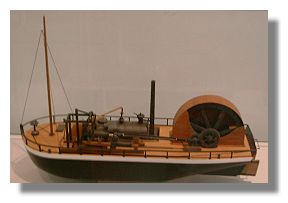Charlotte Dundas
Drawing of the Charlotte Dundas of Robert Bowie
The Charlotte Dundas is regarded as the first viable steamboat in Europe. It was built in 1801 by the Scottish steam engineer, William Symington, who was by the landowners Thomas Dundas, 1st Baron Dundas, a director of the Forth and Clyde Canal, employed. For 7000 pounds Symington built the Charlotte Dundas, which would serve as spare horses to tow the canal boats. For the drive made a Watt's steam engine. Piston transferred the movement on the steering rod and crank directly to the wheel shaft. The machine could produce 10 hp. The 17 meters long and 5.50 meters wide ship towing the two boats, each with 70 tons against strong wind in six hours over a distance of 31.4 km through the channel. The channel owner feared, however, that the waves generated by the paddle wheel of the tractor could damage the bank, so the ship was decommissioned after some time.
A model of the Charlotte Dundas, which was built by the eldest son of the founder, Andrew Symington in 1852, has been preserved: the 76.2 cm long ship model is now in the Museum Victoria in Melbourne, Australia. There also still exists a longitudinal sectional drawing of the vehicle drawn by another son, William Symington.










